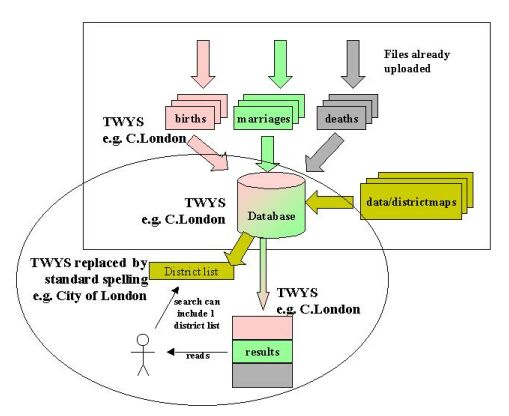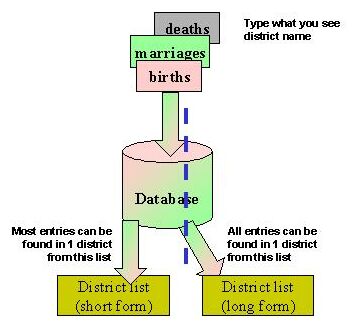
 District Aliasing Overview Page
District Aliasing Overview Page
 District Aliasing Overview Page
District Aliasing Overview PageWelcome to the FreeBMD District Aliasing overview page. This page should provide all the information necessary for you to understand what we are trying to do and to tell you who how the team of district aliasers was formed and how it may grow in future.

|
| The rectangular box gives an overview of what happens when the database
is built and the oval of what happens when the database is searched. |
The aliases do not appear on this list, appearing instead in the search results when the 'standard spelling' for their district is used instead. This reduces the number of searches that are necessary to find an individual that would otherwise be necessary due to minor spelling variations of the district name.
The district alias files also
(i) not every entry can be found using a search based on the standard list of districts for this reason (e.g. Alvondale)
(ii) prior to the change in the search page made in Nov 2002, every entry in the database could be found based on one and only one search using the 'complete list of districts'
 |
| Ambiguous spellings like Alvondale cannot be found
using the short list but used to be on the long form of the district list |
Aliasing means that a spelling such as St Germane does not appear on any list, since it is obviously an alternative spelling for St Germans.
Although the spelling on the district list is shown as St Germans, the information held about an individual entry from an index is held in it's original type what you see format, so the results of the search will comprise mostly of the entries where the district is spelt in the standard way, in this example St Germans, but interspersed with them will be other entries with alternative spellings such as St German and St Germane. Aliasing is the mechanism whereby these aliases are included on this list.
Note: Every spelling on the short form of the district list was also present on the long form of the list.
 |
2 of the reports that are produced as the database is built
1. unk.txt is especially for the district aliasers
2. district-map.htm is for anyone to view the aliases using a browser |
The list is split into chunks based on a letter of the alphabet. For each letter the alias file, called A.txt for the letter A, and the corresponding part of the candidate list, called A_unmatched.txt, is allocated to one of the district aliasers. He or she then adds the appropriate information from A_unmatched.txt to A.txt, and if for example it is appropriate to be aliased to a standard registration district that starts with another letter of the alphabet, he or she emails it to the aliaser who has been allocated the other letter.
However across the years the entries as written were not recorded with a standard spelling. Many of the longer districts have been abbreviated in different ways over the different index books. Also many of the handwritten index books were transcribed to create typeset books, and as in all transcription some errors were introduced. And finally, during the FreeBMD transcription exercise, some of the entries cannot be fully read. In time this should improve as the checking phase completes, but in the meantime the aliasing provides a mechanism for associating partially spelt and mistranscribed districts to a standard registration district.
| Search engine, layout and database
Copyright © 1998-2025 Free UK Genealogy CIO, a charity registered in England and Wales, Number 1167484.
We make no warranty whatsoever as to the accuracy or completeness of the FreeBMD data. Use of the FreeBMD website is conditional upon acceptance of the Terms and Conditions |
 |